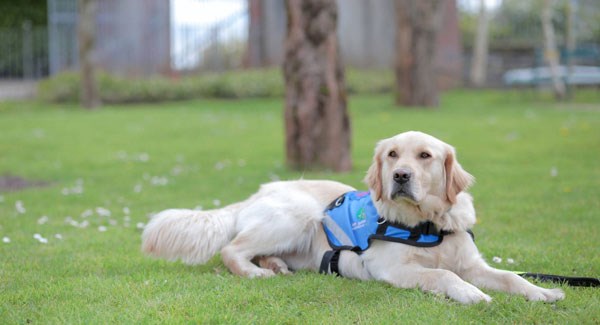Irish Guide Dogs for the Blind are celebrating 40 years of helping the blind, vision impaired and families of children with autism, writes Mags Gargan
Imagine a boy who never plays. A boy who never talks. Who never laughs. Who has no friends. A boy who never hugs anyone, or shows any expression of love. That boy is Conor Lynch. Or rather, it was…
Conor was locked in a world of his own. Diagnosed with severe autism when he was three, Conor was trapped inside a kind of inner world for the first nine years of his life. He never spoke. He was unable to communicate his feelings or his needs to anyone. And his parents were unable to communicate with him.
“I first realised Conor was not coming on properly when he was about 18 months. He never started talking, he never started doing things that other kids that age would do. He was just in a world of his own,” his mum Gillian says.
“As he got older, he would sit on his own for hours and hours just flicking through a magazine. He was just not aware of anything that was going on in the world around him.
“He loves going to school. He loves the routine. But on school holidays his behaviour changes. You can tell when he’s not happy, because he cries and whinges. He doesn’t do that when he’s happy. That’s the only way you know how he’s feeling,” she says.
Impossible
A normal social life was impossible for the Lynch family because of Conor’s mood swings and behaviour when he was away from the routine of home. Family gatherings, holidays, even a simple trip to lunch as a family was impossible.
But ever since a big white retriever called Toby came into his life, things have begun to gradually change in Conor’s world. As though Toby had found the lost Conor trapped inside, and bit by bit, he’s bringing him out.
Conor laughs at things he finds funny now, which began with laughing at Toby. He has made a friend at school and one evening at bedtime recently, Conor beckoned his brother Jamie into his room, put his arms around him and hugged him. It was the first time Conor had ever shown love or affection for another person.
Conor is now calmer. More grounded. He ‘focuses’ on Toby, and takes pride in being with ‘his’ dog.
“Conor used to watch telly jumping up and down, screaming, waving his arms in the air, like he just didn’t know what to do with himself,” Gillian says. “But now, Toby comes in, lies on the floor, and Conor lies down and put his head on his belly and he watches telly like that.
“Toby has changed our lives massively. And not just for Conor. He’s changed things for the whole family. For all of us.”
This is just one of the many success stories for Irish Guide Dogs for the Blind, Ireland’s national charity dedicated to helping people who are blind or vision impaired and families of children with autism to achieve improved mobility and independence.
Now celebrating 40 years, the charity creates between 60 and 70 partnerships with highly trained dogs each year and works with over 180 guide dog owners and 270 assistance dog owners regularly through on-going after care supports totalling over 900 home visits. It also provides over 30 different classes from guide and assistance dogs to independent living and gardening skills at its centre in Cork each year.
“It begins and ends with the dog,” says CEO, Padraig Mallon, as he describes the process from breeding all their own puppies at the centre in Cork to matching them up with the clients.
Training unit
The pups are given to a puppy walker for their first year to train on basic commands as well as toilet training and socialising. They then come back to the early training unit to begin to learn the necessary skills for their work. They are ready to be matched with a client when they are 20 months old.
When the clients apply to the charity they are initially assessed to make sure they will care for the dog and they also receive training to prepare them to work with the dogs.
“What is critical then is the matching and making sure the dog we place is suitable for that person. If I’m living in Dublin and take the Luas and bus every day I need a dog who has a certain level of robustness, and if I’m Ballinrobe and only walk to the shop every so often I need a different type of dog,” Padraig says.
“Relationship is hugely important. This is their companion and friend who works alongside them and there is a high level of friendship.”
When the match has been made the client comes to the centre for up to three weeks residential training. When they then leave with the dog they will continue to receive support in the community.
Any dogs who don’t complete the training for whatever reason have a waiting list of people hoping to home them, and guide dogs who reach retirement age are also popular for rehoming because they are so well trained.
Most of the dogs bred by the charity are a labrador crossed with golden retriever because of their “adaptable, pleasant and happy” character, according to Martin Falvey, a guide and assistance dog instructor.
“A guide dogs won’t work effectively if it’s not happy or doesn’t want to do it,” he explains. “A guide dog only works about 10% of the day, then they are under the desk at work or college or they are at home. An assistance dog works a lot more. It is important that parents get the dog out and about during the day as well, but at home he is a companion dog for the child. The parents are the master but because they are very sensitive dogs there is almost an understanding for the child or a different level of tolerance for the child.
“The two programmes complement each other because your best guide dog would make a rubbish assistance dog and the best assistance dog would make a rubbish guide dog. The difference is a guide dog needs to be outgoing, to want to take on responsibility whereas you want your assistance dog to be more laid back and sensitive,” Martin says.
Volunteer
Martin has been with Irish Guide Dogs for 16 years, originally starting as a volunteer in secondary school, and he says it is a “self-movitating job”. “I love to work with dogs and it’s great to work with the clients as well. We are all responsible for the end product but to be delivering the end product is very rewarding.”
Padraig agrees that it is “very rewarding when you see the impact of the work”. “In terms of our staff, they are very committed. We have a great team of staff and volunteers who love working with dogs and people, and making that opportunity to improve the quality of life for people.”
All of the charity’s services and support is provided free of charge and Padraig says one of their challenges is “that we have finite amount of resources and a very strong level of demand, particularly with the autism service”.
“Our capacity is limited by the supply of dogs available and our funds. We raise up to 85% of our funds through fundraising and voluntary donating and 15% through statutory agencies. Up to about €80,000 a week is required to sustain the organisation, so are so pleased that we have such great volunteer resources around the country raising funds for the service,” he says.
“We have a very connected relationship with a lot of clients. Some are on their 7th or 8th dog. That’s what we do, we work with people for some or all of their life. It is very positive work for the person who gets the dog, the improvement in their quality of life is quite profound and the results of our work are clearly visible.”
For information about volunteering contact 1850 506 300 or email volunteer@guidedogs.ie Or to make a donation see www.guidegogs.ie
‘Heroes’ fundraising campaign
The Irish Guide Dogs for the Blind annual fundraising campaign “Heroes” starts on March 31 and aims to create awareness among people about the services the charity provides and to raise money to continue to provide these services. The campaign aims to shine a light on the heroic behaviour of the dogs, share client stories and show the public the difference that their donations can make to people’s lives. Volunteers will be collecting on street and in shops right throughout the country in April, coinciding with World Autism Awareness day on April 2.


 Mags Gargan
Mags Gargan